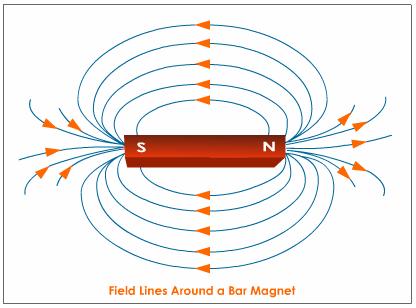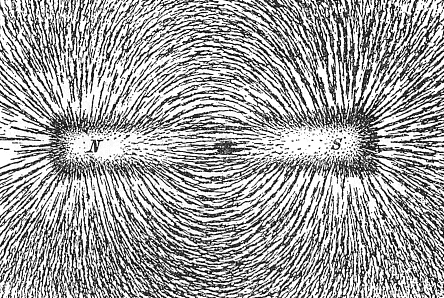
Magnets can do some pretty strange things. In first year physics classes, people are usually introduced to a mysterious thing called a magnetic field. These are invisible lines that help describe how magnets interact. This can make thinking about magnets rather intimidating, as it seems that they must be taken on faith. However, this doesn’t have to be the case!
Classic drawing of a magnetic field for a single magnet. Lines leave the north pole and enter the south pole. Credit: Tutorvista
Magnets interact with lots of things, but in particular are fond of iron. In fact, magnetism as we know it is known as ferromagnetism. In chemistry, “ferrous” means “containing iron”. With this in mind, carefully using tiny bits of iron known as iron filings, magnetic field lines can be seen!
Magnetic field viewed with iron filings. Credit: Henry Black, Practical Physics (1913)
See how the two pictures above line up? This particular picture is very accurate and mapped in painstaking detail. It tells us a lot about the magnet. Magnetic strength is indicated by the density of the magnetic field. In the image above, this shows us that–not surprisingly–the north and south poles of the magnet are the strongest!
What is Ferrofluid?
Back in the early 1960s, a fledgling NASA was presented with lots of new problems. Going to space was unlike anything humans had ever done, and engineers and scientists were constantly searching for answers to issues they had never even considered before.
One of these problems was dealing with the properties of a liquid in low-gravity environments. On Earth, a liquid will stay at the bottom of its containers as gravity pulls it down. But without gravity, the liquid will float all around its container, forming spheres of liquid.
Since the rockets used by NASA relied on liquid fuel, there was a problem getting the fuel pumped to the engines once the spacecraft was in orbit. Several ideas were tried, and though NASA eventually settled on small solid rockets to settle the liquid fuel near the intake, one of the ideas proposed by a scientist named Steve Papell was a ferrofluid fuel.
A ferrofluid is any liquid with metallic metal suspended in it. The metal has a special material coating to prevent the small pieces from attracting or repelling each other, but when the solution is exposed to an exterior magnetic field, the ferrofluid is attracted to the magnet. It also increases in density and becomes somewhat rigid. When Steve Papell suggested using a magnetic fuel, his idea would be to control the flow of the fuel by using magnets. Instead of letting the liquid blob in the center of the tank, it could now be held towards the fuel intake and make the system more efficient. Though it was a good idea, NASA found other, better solutions for the rocket issue. That didn’t mean the end of ferrofluids, however. Another scientist named R.E.Rosensweig improved upon the design and developed a new branch of fluid dynamics known as ferrohydrodynamics. Since then, ferrofluids have been used in many devices — the most common of which is in electronic devices such as hard disks, using it to form liquid seal that will be held in place by magnets. This seal prevents dust and other materials from entering the hard drive.
Looking at a Magnetic Field with Ferrofluid
Magnet and ferrofluid. The magnet isn’t completely covered. There are small spikes where the magnetic field is.
Our magnet is a bit strange, it’s actually two iron spheres attached to two strong neodymium magnets. When arranged in this manner, the entire thing acts as one large magnet. This is sort of the inverse of an important magnetic property: All magnets have a north and a south pole. This means that if you were to cut a magnet in half, it would become two magnets, each with its own north and south pole. This essentially means that each magnet is a stack of smaller magnets, just like the one we are using! Lots of research has been dedicated to finding just a single pole, but these mysterious monopoles remain undiscovered.






